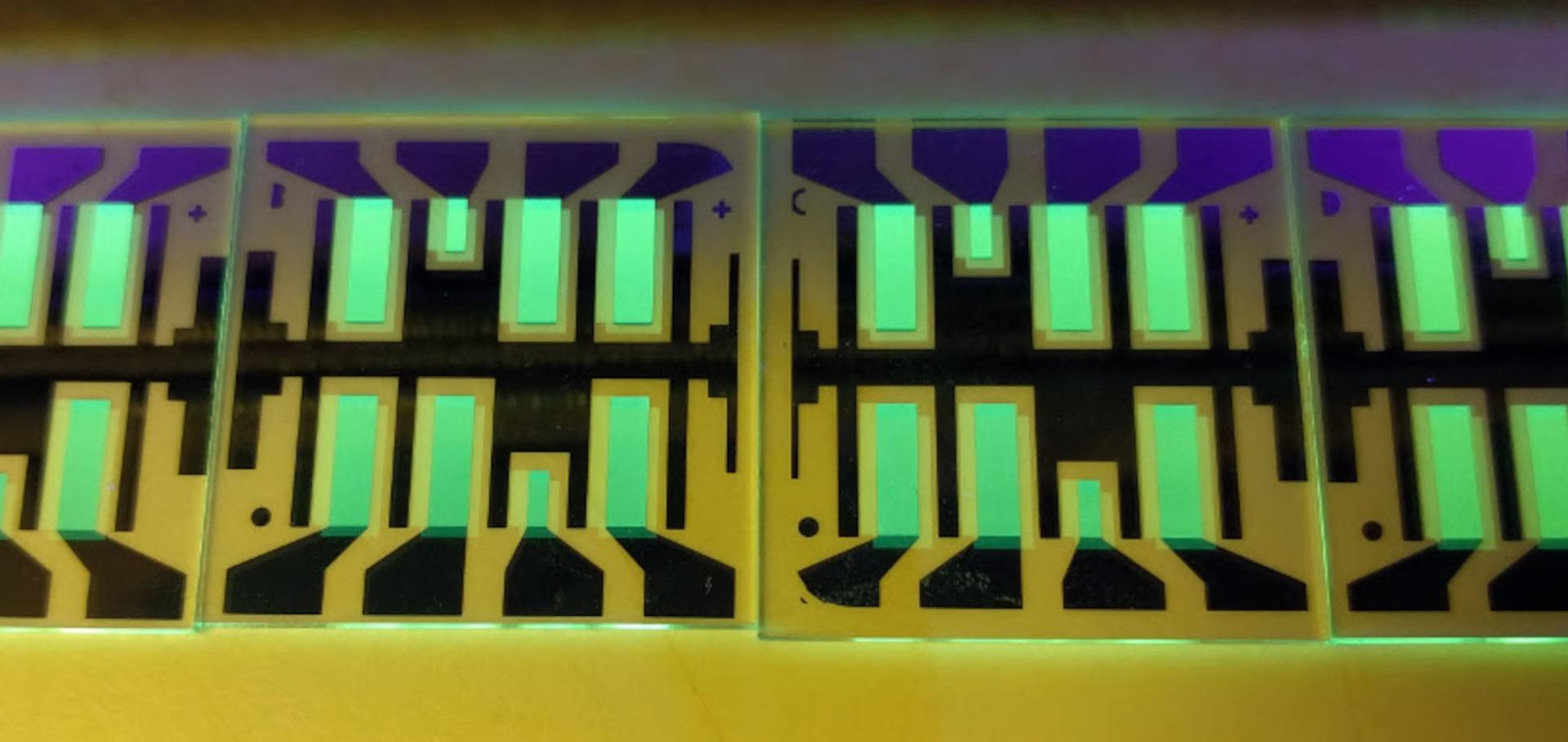Tetrapropyl-tetraphenyl-diindenoperylene derivative as a green absorber for high-voltage stable organic solar cells
Physical Review B - Condensed Matter and Materials Physics 83:16 (2011)
Abstract:
We present small molecule organic solar cells (SMOSC) based on flat heterojunctions (FHJ) of the alternative green donor 2,3,10,11-tetrapropyl-1,4, 9,12-tetraphenyl-diindeno[1,2,3-cd:1',2',3'-lm]perylene (P4-Ph4-DIP) and the fullerene C60. P4-Ph4-DIP absorbs in the green spectral range and thus fills the spectral gap that standard absorber materials (zinc or copper phthalocyanine for red and C60 for blue absorption) leave, thus allowing broad coverage of the sun spectrum, which is of major interest for tandem devices. The materials properties of P4-Ph4-DIP are studied, and SMOSC are characterized by current voltage, external quantum efficiency, and aging measurements. The solar cells display very high fill factors FF > 76% and open circuit voltages VOC of close to 1 V. Mismatch-corrected efficiencies of up to 1.9% are obtained. Aging measurements show that C 60 in conjunction with P4-Ph4-DIP yields extremely stable devices. We observe 88% of the initial efficiency after 2500 h illumination at 999 mW/cm2 illumination intensity, with no observable change in short-circuit current density. Furthermore, we also show that a systematic variation of donor thickness in FHJ can be combined with transfer matrix formalism-based optical simulations and the continuity equation for excitons to reliably determine the exciton diffusion length LD. A value of 9 ± 1 nm is found for P4-Ph4-DIP. © 2011 American Physical Society.Zinc phthalocyanine - Influence of substrate temperature, film thickness, and kind of substrate on the morphology
Thin Solid Films 519:11 (2011) 3939-3945
Abstract:
Zinc phthalocyanine (ZnPc), C32H16N8Zn, is a planar organic molecule having numerous optical and electrical applications in organic electronics. This work investigates the influence of various deposition parameters on the morphology of vapour thermal evaporated ZnPc films. For this purpose, ZnPc is deposited at different substrate temperatures up to 90 °C and film thickness up to 50 nm onto various substrates. The morphology of this ZnPc layers is characterised by X-ray diffraction (XRD), X-ray reflectivity (XRR) and atomic force microscopy (AFM) methods. XRD measurements show that all ZnPc films are crystalline in a triclinic (α-ZnPc) or monoclinic (γ-ZnPc) phase, independent from the kind of substrate, layer thickness, or substrate temperature. The ZnPc powder, the starting product for the thermally evaporated ZnPc films, is present in the stable monoclinic β-phase. Thus, the stacking of the ZnPc molecules changes completely during deposition. The crystallite size perpendicular to the substrate determined by XRD microstructure analysis is in the range of the layer thickness while the lateral size, obtained by AFM, is increasing with substrate temperature and film thickness. AFM and XRR show an increase of the layer roughness for thicker ZnPc layers and higher substrate temperatures during film deposition. The strain in the ZnPc films decreases for higher substrate temperatures due to enhanced thermal relaxation and for thicker ZnPc films due to lower surface tension. © 2011 Elsevier B.V. All rights reserved.Organic Semicondcutors
Chapter in Comprehensive Semiconductor Science and Technology, Volume 4, Elsevier Science & Technology (2011) 4.13
Dicyanovinyl-substituted oligothiophenes: Structure-property relationships and application in vacuum-processed small molecule organic solar cells
Advanced Functional Materials 21:5 (2011) 897-910
Abstract:
Efficient synthesis of a series of terminally dicyanovinyl (DCV)-substituted oligothiophenes, DCVnT 1-6, without solubilizing side chains synthesized via a novel convergent approach and their application as electron donors in vacuum-processed m-i-p-type planar and p-i-n-type bulk heterojunction organic solar cells is described. Purification of the products via gradient sublimation yields thermally highly stable organic semiconducting materials in single crystalline quality which allows for X-ray structure analysis. Important insights into the packing features and intermolecular interactions of these promising solar cell materials are provided. Optical absorption spectra and electrochemical properties of the oligomers are investigated and valuable structure-property relationships deduced. Photovoltaic devices incorporating DCVnTs 4-6 showed power conversion efficiencies up to 2.8% for planar and 5.2% for bulk heterojunction organic solar cells under full sun illumination (mismatch corrected simulated AM 1.5G sunlight). The 5.2% efficiency shown here represents one of the highest values ever reported for organic vacuum-deposited single heterojunction solar cells. © 2011 WILEY-VCH Verlag GmbH & Co. KGaA, Weinheim.Synthesis and characterization of near-infrared absorbing benzannulated aza-BODIPY dyes.
Chemistry 17:10 (2011) 2939-2947


